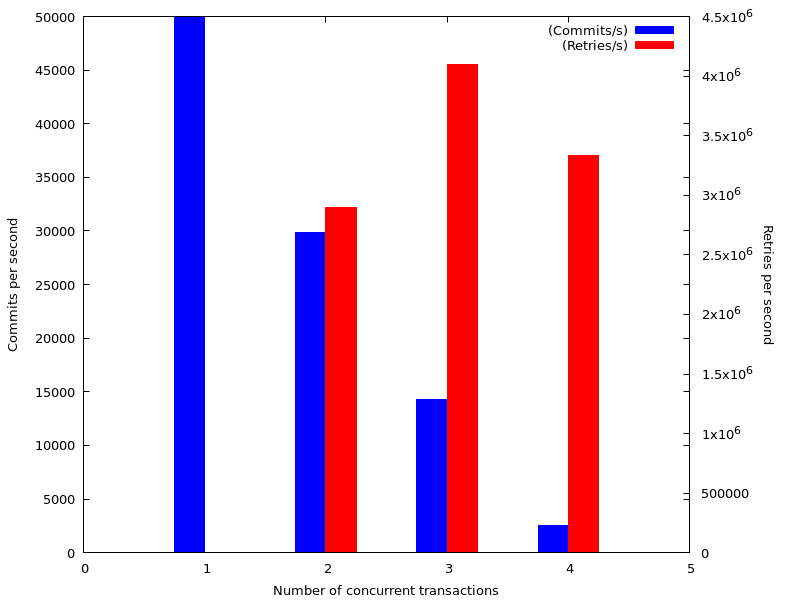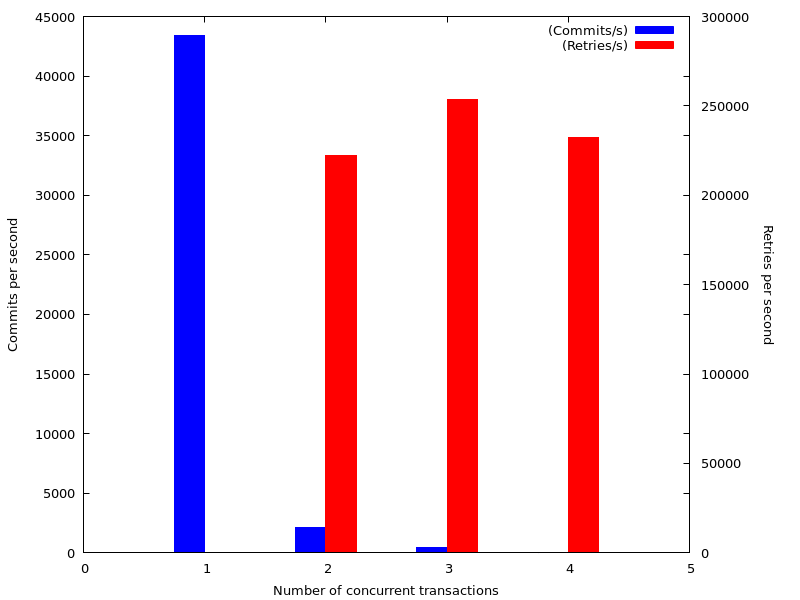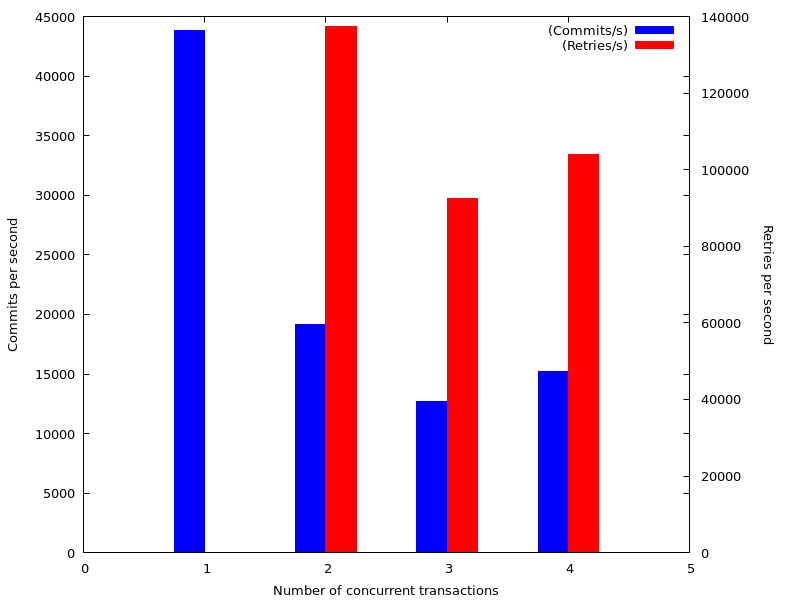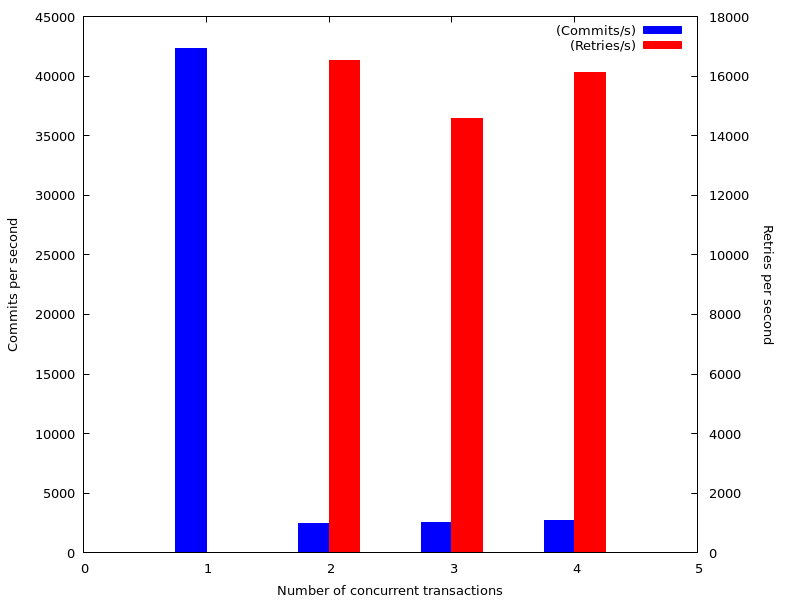Scaling Lock Performance
Release 0.7 of picotm will feature several major improvements of the locking code. In this blog post, we’re going to look at each change and how it impacts performance and scalability. We’ll go from exclusive locks to reader/writer locks to exclusive mode to a dedicated lock manager.
The Test Setup
Picotm is a transaction manager for system-level software. For example, we can write transactions that concurrently perform operations on file descriptors and file buffers, and picotm will detect reader/writer conflicts and errors for us. In the case of a conflict, one of the conflicting transactions has to roll back into its original state and retry. In the case of an error, picotm executes application-specific error handling code.
Our tools for measuring the performance is
picotm-perf. It’s a
simple test tool and comes with a benchmark script
for running a large set of tests.
Tests within picotm-perf operate on transactional memory. Each test
- begins a transaction,
- performs a number of load operations from shared memory,
- performs a number of store operations into shared memory, and
- commits the transactions.
All load and store locations are randomized. The shared memory is a memory buffer that is used for all transactions’ loads and stores. With only 1024 bytes it’s fairly small, so conflicts are more or less guaranteed.
Picotm-perf is a synthetic benchmark; all results are only meaningful relative to each other, but they probably don’t represent real-world performance in any way. Change any parameter and the results could be entirely different.
The test environment is outlined in the PDF files with the results. Note that the test machine has 4 logical processor cores, but only 2 physical cores. The performance won’t scale linearly with the number of cores on such a system.
The Original Code of picotm 0.6
Let’s start with the original implementation that shipped with picotm’s previous release 0.6. It divides the shared memory buffer into small records of 8 bytes and locks each record with an exclusive lock. This means that two transactions observe a conflict when both access the same record concurrently; whether it’s a load or a store operation does not matter.
The benchmark results (pg. 3-8) for random memory access reflect this. Independently from the number of loads and stores, all graphs look the same. Here’s an example of a transaction with 50 loads and 50 stores.

The blue bars and the scale on the left show the number of committed transactions per second; the red bars and the right scale show the number of restarts per second.
We already mentioned the effect of exclusive locks on concurrency. For a single transaction we start with around 50,000 commits per seconds, but go down as we add concurrent transactions ot the test. And that’s even the case if we only run transactions with load operations, which don’t require exclusive locks.
Another problem that becomes obvious from the test results is the extremely high number of restarts. There are up to 4 million restarts per second!
These results gives us our first targets for improvement: enable concurrent access to memory records for transactions that only perform load operations, and reduce the number of restarts.
Adding Reader/Writer Locks
Pull request #140 on GitHub converts the transactional-memory module to use reader/writer locks. These locks are already provided by picotm and used throughout the file-I/O code to protect concurrent access to files and file buffers.
Here’s an example from the test results for reader/writer locks. The transaction again consists of 50 load and 50 store operations.

The results are two-fold. We have reduced the number of restarts by a factor of 10 to 15 to something in the 200 thousands. Unfortunately, this didn’t increase the number of commits per seconds. Quite the opposite actually. With more than one transaction present, the result drops to a few 1.000 commits per second.
An exception is the case of the load-only transactions, shown on page 8 of the PDF file. With the new reader/writer locks, reader transactions finally start scaling.
At this point it’s worth remembering that our shared memory buffer is only 1 KiB in size. With a buffer size that small, as soon as we have write operations in our transaction, conflicting access among transactions are likely.
The low number of concurrent commits is the result of the small buffer size and the interactions between concurrent transactions, competing for locks. We have hit a pathological corner case. If we could guarantee progress to some transactions, things might improve. One simple way of doing this is a limit on the number of restarts per transaction.
Adding Exclusive Mode
Exclusive mode is a variant of irrevocability. In exclusive mode, we run one single transaction exclusively. All other transactions are blocked and consequently conflicts among transcations cannot occur.
Pull request #141 on GitHub enables exclusive mode on top of the reader/writer patch set. After a transaction has reached 10 retries, picotm stops all other transactions, which now have to wait until completion of the exclusive one. The limit has been choosen arbitrarily and its optimum depends on the workload and access patterns.
The complete results are in this PDF file. Here’s an example.

The results look really promising. By limiting the number of restarts per transaction, we have reduced the overall number of restarts by factor 10 to 100,000 to 140,000 restarts per second. At the same time we increased the number of concurrent commits by a factor of 10 to up to 20,000.
On top of the scalability improvements, exclusive mode offers another important feature: transactions are now guaranteed to commit and our overall system will make progress in any case. Imagine a scenario where transactions constantly conflict with each other, restart, and conflict again without ever getting out of this pattern. This is called a livelock. With the previous implementation this was very much possible; with the new implementation not so. With this patch set, we did not just improve scalability, we resolved a whole class of concurrency problems.
Even with our current patch set we still observe 100,000 to 140,000 restarts per second. These restarts are required to avoid cyclic dependencies among transactions, as all locks held by a transaction are released if the transaction restarts. By simply never waiting, no cyclic dependencies, and therefore no deadlocks, can occur.
Our next improvement will try to reduce the number of restarts by not restarting after all. That’s what a lock manager does.
Adding a Lock Manager
The lock manager is a software component within picotm that
- maintains lists of transactions waiting for each reader/writer lock, and
- schedules waiting transactions when a lock becomes available.
The actual implemenation is quite complex and worth a separate blog post. The overall algorithm can be summarized like this
- A transaction tries to acquire a reader/writer lock.
- If the transaction fails to acquire the lock, it instructs the lock manager to make it wait for the lock to become available.
- The lock manager inserts the transaction into a waiting queue for the lock.
- When the lock becomes available, the unlocking transaction instructs the lock manager to select one or more of the waiting transactions and wake them up.
- In the waiters
- the woken-up transactions try again to acquire the lock.
- If a transaction has not been woken up after a certain timeout, it wakes up automatically and a tries to acquire the lock.
- Only if a transaction fails a second time to acquire the lock, it restarts; otherwise it continues as if lock acquisition had been successful on the first try.
Point 5.2 is required to avoid cyclic dependencies, and therefore deadlocks, among waiting transactions. If the waiting time has an upper bound, cyclic dependencies will be resolved as soon as the timeout has been reached and one of the transactions restarts.
Lock management gives us a new quality of locking: we now know which transaction waits for which lock, we can keep statistics about each transaction’s locking patterns, and we have a central place that coordinates locks among transactions.
At the moment the results are again two-fold. Here’s our example result.

Compared to the previous patch set, we have reduced the number of restarts by another factor of 8 to 14.000 to 16.000 restarts per second. Compared to the 4 million restarts per second with picotm 0.6 that’s an overall improvement by factor 250. Amazing!
Unfortunately, lock management actually decreased the number of commits per second significantly. The reason is in the high overhead of maintaining the waiter lists and suspending the waiting transactions, which involves a number of system calls. That’s significant compared to the fast load and store operations that are required for simply restarting.
Where To Go From Here?
picotm 0.7 will feature all of the improvements we discussed in this blog post. Reader/writer locks and the exclusive mode are definitely useful changes.
The lock manager will be available, but probably not be used for the most part. For these memory-only transactions of our test program, maintaining waiter lists and suspending transactions makes no sense, because simply restarting conflicting transactions in exclusive mode gives much better results.
The situation changes with longer transactions that may even have a higher system-wide overhead. For example, file I/O requires system calls for reading and writing data in the file buffer. The longer such a transaction runs, the more likely it is that it reaches a tiping point where waiting is the better option over restarting immediately.
Our current lock manager’s transaction scheduler always wakes up the longest waiting transaction when the lock becomes available. That’s probably not optimal in most situation. By maintaining better locking statistics for each transaction, we can make better decisions about which transaction to wake up. There are zillions of strategies and tuning parameters to explore!
Summary
In this blog post, we’ve looked at the impact of different locking patch sets to the scalability and performance of picotm’s transactions.
- Exclusive locks don’t scale well, lead to a large number of conflict restarts, and don’t allow for concurrent readers.
- Reader/writer locks improve concurrency in setups with many reader transactions and only few conflicts. They are not that helpful if conflicts with writer transactions are likely.
- Switching transactions to an exclusive mode after they reached a limited number of restarts further improves scalability and prevents livelocks.
- Lock management can significantly reduce the number of restarts, but imposes overhead on the transactions.
If you like this blog post, please subscribe to the RSS feed, follow on Twitter or share on social networks.
Post by: Thomas Zimmermann